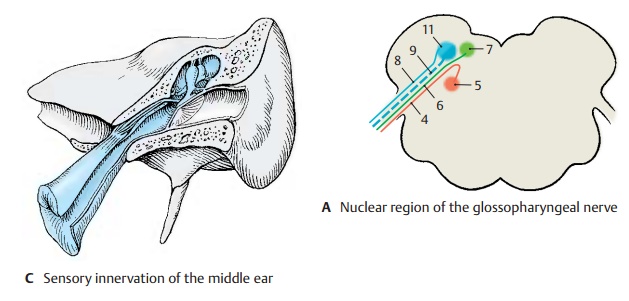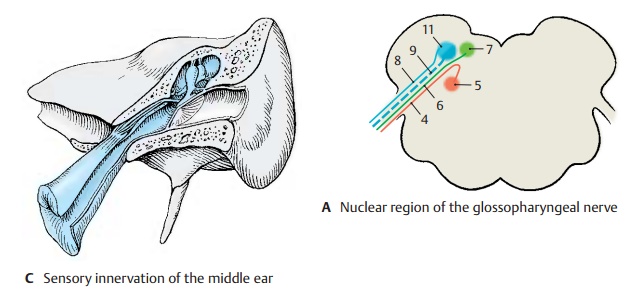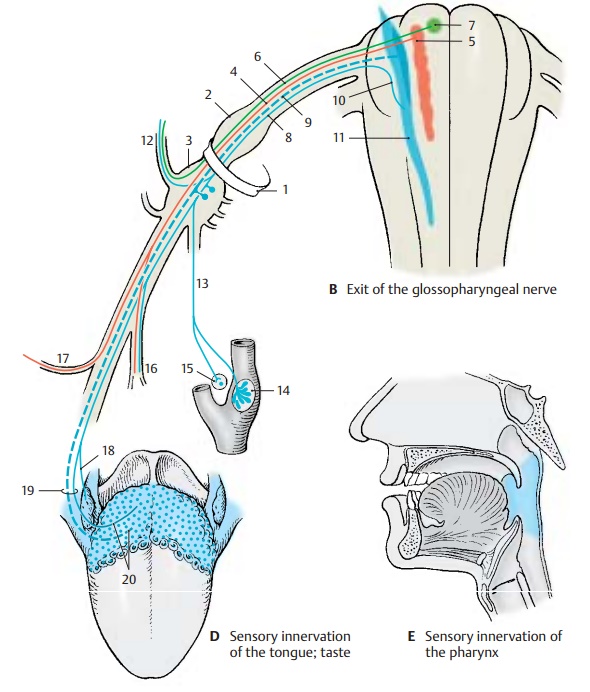Chapter: Human Nervous System and Sensory Organs : Brain Stem and Cranial Nerves
Glossopharyngeal Nerve - Cranial Nerves (V, VII - XII)

Glossopharyngeal Nerve
The ninth cranial nerve supplies sensory
fibers for the middle ear, areas of
the tongue and of the pharynx, and motor fibers for the
muscles of the pharynx. It contains
motor, visceromotor (parasympathetic), viscero-sensory, and taste fibers. It
emerges from the medulla oblongata behind the olive right above the vagus nerve
and leaves the skull together with the vagus nerve through the jugular foramen (B1). In the foramen, it forms the superior ganglion (B2)
and, after passing through it, the larger inferior
gan-glion (petrosal ganglion) (B3). Laterally tothe internal carotid
artery and the pharynx, it forms an arch to the root of the tongue where it
ramifies into several terminal branches.

The motor fibers (AB4) originate from the cranial part of the ambiguous nucleus (AB5), whilethe visceroefferentfibers(secretory fibers) (AB6)
originate from the inferior salivatory
nucleus (AB7). The cellsof the viscerosensory fibers (AB8) and the tastefibers (AB9) lie in
theinferior ganglionanddescend in the
solitary tract (B10) to termi-nate at specific levels of the solitary nu-cleus (AB11).
The first
branch, the tympanic nerve (B12), originates from the inferior
ganglion with viscerosensory and preganglionic secretory fibers in the petrosal
fossula. It runs through the tympanic
canaliculus into the tympaniccavity,
where it receives fibers from theplexus of the internal carotid artery via the caroticotympanic nerve and forms thetym-panic plexus. It supplies sensory
fibers to themucosa of tympanic cavity and auditory(eustachian)
tube (C). The secretory
fibersrun as lesser petrosal nerve to the otic gan-glion.
Apart
from connections with the vagus nerve, facial nerve, and sympathetic nervous
system, the inferior ganglion gives off the (viscerosensory) branch of the carotidsinus (B13), which descends to the
bifurca-tion of the common carotid artery and ter-minates in the wall of the carotid sinus (B14) and in the carotid
glomus (B15) .

The
nerve transmits impulses of the mechanoreceptors
of the sinus and the chemoreceptors of
the glomus to themedulla oblongata and via collaterals to the posterior nucleus
of the vagus nerve (affer-ent limb of the sinus reflex). Preganglionic fibers
run from the vagal nucleus to groups of neurons in the cardiac atria, the axons
of which (postganglionic parasympathetic fibers) terminate at the sinoatrial
node and the atrioventricular node (efferent limb of the sinus reflex). This
system registers and regulates the blood pressure and heart rate.
The
nerve also gives off the pharyngealbranches
(B16); together with the part of
thevagus nerve, they form the pharyngeal plexus and participate in the sensory
(E) and motor supply of the pharynx.
A motor branch, the stylopharyngeal
branch (B17), in-nervates the stylopharyngeal muscle, while some
sensory tonsillar branches (D18) extend to the tonsils and the soft
palate. The nerve divides below the tonsils into the lingualbranches (D19),
which supply the posteriorthird of the tongue including the vallate papillae
with sensory as well as taste fibers (D20).
Related Topics